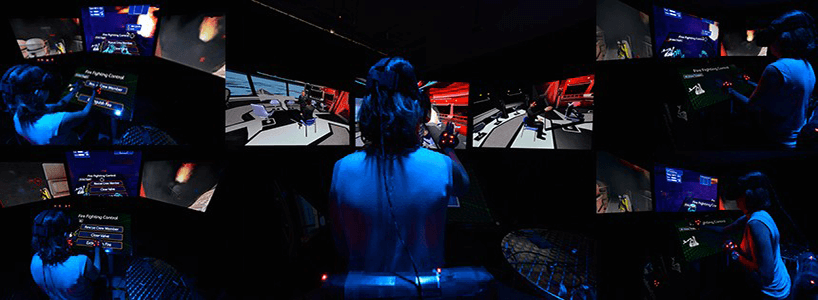The first time I entered virtual reality was at a party last month. The host mentioned over drinks that he had an Oculus Rift and asked if we’d like to try it. We did, and when it was my turn, it took about three seconds for me to realize that nothing would ever be the same again. I was standing on the launch pad at Kennedy Space Center, looking straight up at a Saturn V rocket, atop which was a capsule bound for the moon. It was so large, the rocket, and it was a beautiful day for a launch. I was an astronaut—I could look down and see the suit on my body—and I’d soon be taking one small step for a man and one giant leap for mankind.
What most strikes you and unnerves you when you’re in virtual reality is that while your rational mind knows that you are still physically in the real world—a living room in my case—your brain very quickly accepts that it is somewhere else. The real world, after all, is the place your senses reveal to you. The beauty of the Oculus rig is that your field of view is fully covered—your eyes work as normal and take in surroundings accordingly. The outside world is sealed off, and as far as your brain is concerned, no longer exists. And this is only the first version of the technology. Five years from now, I wonder if we’ll even be able to tell the two apart—reality and virtual—and I wonder what the implications of that might be.
INDUSTRY HAS AWAKENED TO VR
I mention all this because the defense industry is certainly interested in the applications of such technology. For no other reason, then, virtual reality is about to become a job market unto itself, and there will be a lot of openings at the table for job seekers who possess a security clearance. The applications of VR are legion: you can train soldiers to handle any situation in any war zone imaginable—not only firefights, but little things: dealing with locals; spotting IEDs; performing a battlefield triage; repairing a helicopter. They will do these things without the clunky rigs or cheesy scenarios found in existing simulation technologies. Soon, when soldiers do these things they will all but exist in those worlds, and will react accordingly.
The intelligence community has the same opportunities. You can put an agent in the field—any field—load a scenario, and see how they react. You’ll see exactly what they saw, and exactly what they missed, and so on. And it only gets more exciting from there. The graphics are incredible today, but consider the realism of a virtual world whose data is drawn directly from the satellites of the National Reconnaissance Office and National Geospatial Intelligence Agency. Imagine Special Forces teams running through a mission and seeing exactly what they’re going to see on the ground? Already, infantry and special operations sometimes wear helmet cameras. But 360-degree cameras are plunging in price and shrinking rapidly. GoPro already has such a camera on the market, and is perhaps a single generation away from making it helmet ready.
The point is that once such cameras find their way onto the battlefield, after action reports will involve soldiers donning VR rigs like the Oculus Rift or GearVR and reliving firefights able to look up, down, left right—in other words—to get into the heads of the soldiers on the field, and see what they saw, and what they didn’t. VR recordings of textbook successes can be saved and introduced into the military classroom. Training will never be the same.
virtual reality JOBS in the CLEARANCE world
Companies are starting to hire for these jobs today. Not every opening calls for code gurus, but every opening does call for a security clearance—which is good news for you. The future is here, and you have a fast-pass to the front of the line.
Among the many VR jobs listed on ClearanceJobs: Parsons in Aberdeen, Md. is hiring computer scientists to work with the U.S. Army Research Laboratory Computational and Information Sciences Directorate. The job involves data visualization and the Unity game engine (the same engine that powers Pokemon Go). Meanwhile, CAE USA at Fort Campbell is looking for a Geospatial Database Administrator. Among many other things, the job will require you to “extract, extrude, and produce 3-D feature models from overhead collection sources,” which sounds a lot like what I described above. (You will be building the future of warfare!)
Moving westward on the map, Sandia National Laboratories wants a developer who has “experience with 3D game development, augmented reality or virtual reality content creation.” Because it’s unlikely that Sandia—whose role is vital in the U.S. nuclear weapons program—plans to start a video game division, it sounds like VR is about to go big in ways none of us—save the ClearanceJobs applicant who actually gets the job—can even imagine. Over at Leavenworth, Trideum Corporation needs someone to provide technical support for “Battlefield Visualization (virtual UAV) operation and training during division and corps level Warfighter Exercises (WFXs), Mission Rehearsal Exercises (MRXs) and similar related exercises.”
The only analogue for VR today is app development when the first iPhone dropped. Everyone knew it would be big, but nobody knew how big. In the end, the world changed, with app developers its new tech titans. If you missed that boat, the next one has arrived, and the ocean waits to be conquered. You have the skills, you have the drive, and you have the security clearance. It’s a new year—go for it.




